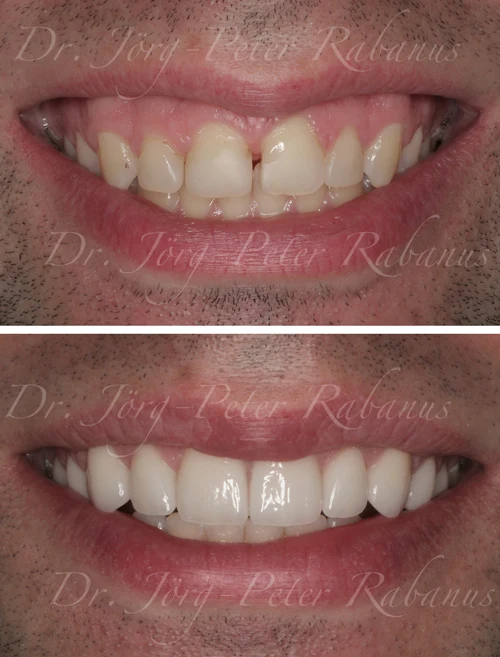Designing New Smiles With Porcelain Veneers

Smile Makeovers with Porcelain Veneers
The combination of gum recontouring and porcelain veneers, as illustrated with the before-and-after images above, resulted in transformative outcomes:
- Reduced Gum Visibility: The gum lift minimized the amount of pink tissue visible during the patient’s smile.
- Enhanced Gingival Zeniths: Adjustments to the gingival zeniths—the highest points of the gumline adjacent to the teeth—refined the apparent dental axes of the upper anterior teeth.
- Improved Gum Scalloping: Reshaping the gumline created proper dental emergence profiles, enhancing the overall aesthetics.
- Durable Aesthetic Results: Porcelain veneers provided a long-lasting glossy surface and a naturally appealing appearance.
Understanding the Causes of Small Teeth and Gaps
Natural smiles vary in shape and form, but one common concern involves small teeth accompanied by noticeable gaps, also known as diastemas, between neighboring teeth. This condition typically arises from a mismatch between the length of the maxillary arch and the combined widths of the maxillary teeth. While orthodontic treatment is a traditional method for closing these interdental spaces, it does not address the relatively small size of the natural teeth, often leaving the smile still appearing undersized.
With advancements in porcelain materials and bonded ceramic restorations, laminate veneers have become a valuable and effective treatment option. These veneers not only close gaps but also address the small size and proportion of the teeth, delivering a comprehensive smile enhancement.
Limitations of Orthodontic Treatment
Orthodontic treatment often necessitates the use of fixed or removable retainers to maintain alignment, sometimes for many years. While effective for straightening teeth, retainers introduce challenges such as:
- Interference with oral hygiene
- Potential speech difficulties
- Discomfort and inconvenience
For patients with small teeth and interdental spacing, porcelain veneers can provide a simpler, more aesthetically pleasing solution. Unlike composite materials, which dull over time, porcelain veneers maintain their glossy finish and natural appearance. Additionally, veneers eliminate the need for retainers, offering a low-maintenance option for achieving a lasting smile transformation.
Advantages of Porcelain Veneers
Once porcelain veneers are bonded to the teeth, patients can enjoy their new smile without the hassle of ongoing maintenance. Veneers offer several distinct benefits:
- Aesthetic Longevity: Porcelain retains its gloss and resists staining over time, unlike composite materials.
- Maintenance-Free Alignment: Veneers eliminate the need for retainers, simplifying post-treatment care.
- Natural Appearance: Porcelain mimics the translucence and texture of natural teeth, ensuring a seamless result.
This makes veneers an ideal choice for addressing both functional and aesthetic concerns related to small teeth and diastemas.
Key Considerations for Cosmetic Dentists
While laminate veneers are frequently requested for smile enhancement, a skilled cosmetic dentist must possess a deep understanding of natural tooth anatomy, oral function, and engineering principles. These factors ensure that the restorations are not only visually appealing but also durable and functional. The process should follow a systematic, step-by-step approach, allowing the patient to test and approve the design before final placement.
The Role of Temporary Veneers
One crucial step in custom smile design is the placement of temporary dental veneers. This stage allows the patient to preview their new smile and provide feedback. The final design is only completed after the temporary veneers are adjusted to meet the patient’s expectations. This collaborative approach ensures satisfaction and minimizes the need for post-placement adjustments.
The Importance of Adhesive Technology
Delivering porcelain restorations that last for many years requires expertise in dental adhesive technology. Proper bonding techniques are essential to ensure that the veneers remain securely in place and maintain their aesthetic integrity. Experience and technical knowledge are indispensable for achieving a successful outcome.
Conclusion
Porcelain veneers offer a transformative solution for patients seeking to enhance their smiles. By addressing the root causes of small teeth and gaps, veneers provide a durable, low-maintenance, and aesthetically pleasing option. For individuals dissatisfied with their natural smiles or previous dental work, porcelain veneers—combined with gum recontouring when necessary—can deliver remarkable, lasting results. A thorough understanding of dental anatomy, adhesive techniques, and patient preferences is essential for cosmetic dentists to create smiles that are not only beautiful but also functional and enduring.
Further Resources
For more information about porcelain veneers and to explore additional smile transformations, consult resources dedicated to this advanced dental treatment. If you're curious about alternatives like lumineers, consider speaking with a cosmetic dentist to understand which option best suits your needs:
Sękowska A et al. The size of anterior teeth in patients with gaps in the upper dental arch. Folia Morphol (Warsz). 2015;74(4):493-6
Duarte S Jr et al. The importance of width/length ratios of maxillary anterior permanent teeth in esthetic rehabilitation. European J Esthetic Dentistry. 2008 Autumn;3(3):224-34.
Raj V. Esthetic paradigms in the interdisciplinary management of maxillary anterior dentition-a review. J Esthetic Restorative Dentistry. 2013 Oct;25(5):295-304.
Frese C et al. The assessment of dentofacial esthetics in restorative dentistry: a review of the literature. J American Dental Assoc. 2012 May;143(5):461-6.
Dr. Rabanus' dental office is located at Best Cosmetic Dentist San Francisco.



